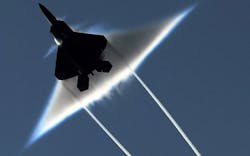Air Force wants new electronics thermal management techniques for fighter aircraft
WRIGHT-PATTERSON AFB, 4 Aug. 2015. U.S. Air Force electronics thermal management experts are asking industry for new ideas on how to cool the electronics on future fighter aircraft, which could be at least 10 times more demanding than they are today.
Officials of the Air Force Research Laboratory at Wright-Patterson Air Force Base, Ohio, issued a broad agency announcement Friday (BAA-AFRL-RQKP-2015-0002) for the Hybrid-Cycle Power and Thermal Management System (PTMS) project.
The Air Force Research Lab's Power and Control Division, Mechanical & Thermal Systems Branch are asking industry for electronics cooling ways to blend air-cycle cooling, vapor-cycle cooling, chilled fuel, and other thermal energy storage mechanisms to keep electronics cool on future jet fighters.
Next-generation fighter aircraft will require an unprecedented level of advanced capabilities to operate in contested environments, including advanced electronic attack, high-power lasers, and low-observability features, researchers say. These systems will require as much as 10 times more power than today's fighters do.
On these future power-hungry aircraft, thermal management may be an even bigger concern than generating power because component efficiencies and waste heat qualities will be low, researchers say.
Compounding the electronics-cooling problem will be modern jet fighter design factors like composite aircraft skins, high-efficiency engines, and deeply embedded aircraft systems compound these challenges. Other challenges involve varied duty cycles of power loads on these future aircraft, which on a typical mission can change from continuous to less than 5 percent. This will require a wide thermal management system.
Conventional air cycle systems offer relatively high temperature lifts over comparable vapor cycle systems, yet vapor cycle systems generally are 10 times more efficient at moving heat, which could reduce heat-rejection demands on vehicle thermal sinks.
Vapor cycle systems also could reduce shaft power requirements, and engine-cycle cooling is more efficient than bleed-air-driven air cycle systems. Researchers also are interested in using chilled fuel or other thermal energy storage mechanisms for electronics cooling.
In sum, researchers are interested in the ability to use available heat sinks selectively in the most optimal way to ensure sufficient and efficient electronics cooling.
The Hybrid-Cycle Power and Thermal Management System project could be worth as much as $24 million and involve as many as six companies through 2019.
Related: Keeping cool with hot electronics
Companies interested should notify the Air Force of their intent to propose no later than 19 Aug. 2015. Full proposals are due no later than 11 Sept. 2015. Email intents and proposals to the Air Force's Sally Roliff at [email protected].
For technical questions contact the Air Force's Capt. Daniel Hatzung by email at [email protected], or by phone at 937-255-6214.
For contracting questions contact Sally Roliff by email at [email protected], or by phone at 937-713-9954; or Sarah Chaffe by email at [email protected] or by phone at 937-713-9952, [email protected].
More information is online at https://www.fbo.gov/spg/USAF/AFMC/AFRLWRS/BAA-AFRL-RQKP-2015-0002/listing.html.

